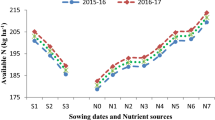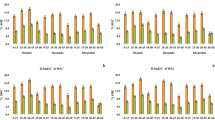Abstract
A field experiment during 2010–2014 was conducted at Indian institute of Sugarcane Research, Lucknow, with three tillage practices (T 1: control—two times ploughing through harrow and cultivator, each followed by planking before sugarcane planting, T 2: deep tillage through disc plough (depth 25–30 cm) before planting followed by harrowing, cultivator and planking and T 3: subsoiling at 45–50 cm, and deep tillage through disc plough/mouldboard plough (depth 25–30 cm) followed by harrowing, cultivator and planking before planting), two soil moisture regimes (M 1: 0.5 IW/CPE ratio and M 2: 0.75 IW/CPE ratio) at 7.5 cm depth of irrigation water, and four N levels (N1-0; N2-75; N3-150; N4-225 kg N/ha) in sugarcane crop. The higher mean SMBN (16.61 mg NH4–N/m2/day) during sugarcane ratoon crop was analysed as compared to plant crop (12.97 mg NH4–N/m2/day). Suboptimal moisture regime (0.5 IW/CPE) in plant crop reduced SMBN at all the stages of growth as compared to optimum moisture regime (0.75 IW/CPE). Mean SMBN at 0.5 IW/CPE was observed as 16.22 mg NH4–N/m2/day vis-à-vis 17.00 mg NH4–N/m2/day at 0.75 IW/CPE. The increasing levels of N up to 225 kg/ha increased SMBN at all the stages in both the soil depths, i.e. 0–15 and 15–30 cm (17.60 mg NH4–N/m2/day at 225 kg N/ha over 15.56 mg NH4–N/m2/day at N0). Deep tillage and subsoiling (T 3) at 0.75 IW/CPE ratio and 225 kg N/ha showed the highest mean soil respiration (158 mg CO2–C/m2/day). In sugarcane plant crop, at the highest N application (225 kg N/ha), M 1 (0.50 IW/CPE) showed the lowest available N, i.e. 160 kg N/ha vis-à-vis 186.00 kg/ha at 0.75 IW/CPE (M 2) with conventional tillage (T 1). Deep tillage increased production of millable canes which could be increased to 100,830/ha in sugarcane plant crop and 106,710/ha in ratoon crop. Mean sugarcane and sugar yields in plant crop was 68.97 and 8.28 t/ha vis-à-vis 83.67 and 10.03 t/ha in ratoon crop, respectively. Sugarcane plant crop showed 21.52 % increase in cane weight (774.75 g) due to adoption of deep tillage and subsoiling. Thus, it could be concluded that subsoiling at 45–50 cm depth followed by deep tillage at 20–25 cm depth once before planting of sugarcane with scheduling of irrigation at 0.75 IW/CPE soil moisture regime and 150 kg N/ha sustained soil microbial biomass N and in situ soil respiration besides increasing sugarcane and sugar yields in plant–ratoon system.


Similar content being viewed by others
References
Álvaro-Fuentes, J., C. Cantero-Martínez, M. López, and J. Arrúe. 2007. Soil carbon dioxide fluxes following tillage in semiarid Mediterranean agroecosystems. Soil and Tillage Research 96: 331–341. doi:10.1016/j.still.2007.08.003.
Austin, A.T., L. Yahdjian, J.M. Stark, J. Belnap, A. Porporato, U. Norton, D.A. Ravetta, and S.M. Schaffer. 2004. Water pulses and biogeochemical cycles in arid and semiarid ecosystems. Oecologia 141: 221–235.
Baan, C.D., M.C.J. Grevers, and J.J. Schoenau. 2009. Effects of a single cycle of tillage on long-term no-till prairie soils. Canadian Journal of Soil Science 9: 521–530. doi:10.4141/cjss08041.
Chen, X.W., W.M. Post, R.J. Norby, and A.T. Classen. 2011. Modeling soil respiration and variations in source components using a multi-factor global climate change experiment. Climate Change 107: 459–480. doi:10.1007/s10584-010-9942-2.
Ciais, P., M. Wattenbach, N. Vuichard, P. Smith, S.L. Piao, A. Don, S. Luyssaert, I.A. Janssens, A. Bondeau, R. Dechow, A. Leip, P.C. Smith, C. Beer, G.R. Van der Werf, S. Gervois, K. Van Oost, E. Tomelleri, A. Freibauer, and E.D. Schulze. 2010. The European carbon balance. Part 2: Croplands. Global Change Biology 16: 1409–1428. doi:10.1111/j.1365-2486.2009.02055.
Cocharan, W.G., and G.M. Cox. 1957. Experimental designs, 2nd ed, 463–466. New York: Wiley.
Diouf, O., Y.C. Brou, M. Diouf, B. Sarr, M. Eyletters, H. Roy-Macauley, and J.P. Delhaye. 2004. Response of pearl millet to nitrogen as affected check year by water deficit. Agronomie 24: 77–84. doi:10.1051/agro:2004001.
Dungait, J.A., D.W. Hopkins, A.S. Gregory, and A.P. Whitmore. 2012. Soil organic matter turnover is governed by accessibility not recalcitrance. Global Change Biology 18: 1781–1796. doi:10.1111/j.1365-2486.2012.02665.x.
Harrison, D.F., K.C. Cameron, and R.G. Mclaren. 1994. Effects of subsoil loosening on soil physical properties, plant root growth, and pasture yield. New Zealand Journal of Agricultural Research 37: 559–567.
Hou, X.Q., Z.K. Jia, Q.F. Han, H.X. Sun, W. Wang, J.F. Nie, and B.P. Yang. 2012a. Effects of different rotational tillage patterns on soil structure, infiltration and water storage characteristics in dry land. Transactions of the Chinese Society of Agricultural Engineers 28: 85–94. (In Chinese).
Hou, X.Q., R. Li, Z.K. Jia, Q.F. Han, W. Wang, and B.P. Yang. 2012b. Effects of rotational tillage practices on soil properties, winter wheat yields and water-use efficiency in semi-arid areas of north-west China. Field Crops Research 129: 7–13. doi:10.1111/j.1475-2743.2012.00429.
IASRI. 2015. Online data analysis in SAS programme under Strengthening Statistical Computing for NARS, Indian Agricultural Statistics Research Institute, New Delhi. http://stat.iasri.res.in/sscnarsportal.
Jackson, M.L. 1973. Soil chemical analysis. New Delhi: Prentice-Hall of India Pvt, Ltd.
Jackson, L.E., F.J. Calderon, K.L. Steenwerth, K.M. Scow, and D.E. Rolston. 2003. Responses of soil microbial processes and community structure to tillage events and implications for soil quality. Geoderma 114: 305–317. doi:10.1016/S0016-7061(03)00046-6.
Jenkinson, D.S., and D.S. Powlson. 1976. The effects of biocidal treatments on metabolism in soil—I. Fumigation with chloroform. Soil Biology & Biochemistry 8: 167–177.
Karaca, A., S.C. Cetin, O.C. Turgay, and R. Kizilkaya. 2011. Soil enzymes as indication of soil quality. In Soil enzymology, ed. G. Shukla, and A. Varma, 119–148. Berlin: Springer.
Knorr, M., S.D. Frey, and P.S. Curtis. 2005. Nitrogen additions and litter decomposition: A meta-analyses. Ecology 86: 3252–3257.
Kooistra, M.J., and N.K. Tovey. 1994. Effects of compaction on soil microstructure. In Soil compaction in crop production, ed. B.D. Soane, and C. Van Ouwerkerk, 91–111. New York: Elsevier.
Lal, R. 1993. Tillage effects on soil degradation, soil resilience, soil quality, and sustainability. Soil Tillage Research 27: 1–8. doi:10.1016/0167-1987(93)90059.
Matzner, S.L., and J.H. Richards. 1996. Sagebrush (Artemisia tridentate Nutt.) roots maintain nutrient uptake capacity under water stress. Journal of Experimental Botany 47: 1045–1056. doi:10.1093/jxb/47.8.1045.
Metting, F.B. 1993. Structure and physiological ecology of soil microbial communities. In Soil microbial ecology: Applications in agricultural and environmental management, ed. F.B. Metting, 3–25. New York: Marcel Dekker.
Mao, H.L., J. Li, Z.K. Jia, and L. Wang. 2010. Soil water conservation effect, yield and income increments of conservation tillage measures on dry land wheat field. Transactions of the Chinese Society of Agricultural Engineering 26: 44–51. (in Chinese).
Meady, G.P., and G.C.P. Chen. 1977. Cane sugar handbook, 10th ed, 882–885. New York: Wiley.
Page, A.L., Miller, R.H., and D.R. Keeney. 1982. In Method of soil analysis Part 2, eds. 949–1008. Madison: ASA Inc.
Sänger, A., D. Geisseler, and B. Ludwig. 2010. Effects of rainfall pattern on carbon and nitrogen dynamics in soil amended with biogas slurry and composted cattle manure. Journal of Plant Nutrition and Soil Science 173: 692–698. doi:10.1002/jpln.200900254.
Shahidi, B.M.R., M. Dyck, and S.S. Malhi. 2014. Immediate and short-term effects of tillage of long-term no-till on carbon dioxide greenhouse gas emissions from two contrasting Canadian prairie soils. Soil and Tillage Research 144: 72–82. doi:10.1016/j.still.2014.07.008.
Smolander, A., L. Barnette, V. Kitunen, and I. Lumme. 2005. N and C transformations in long-term N-fertilized forest soils in response to seasonal drought. Applied Soil Ecology 29: 225–235. doi:10.1016/j.apsoil.2004.12.002.
Shukla, S.K., M. Lal, and S.K. Singh. 2013. Improving bud sprouting, growth and yield of winter initiated sugarcane ratoon. Soil and Tillage Research 126: 50–59. doi:10.1016/j.still.2012.07.016.
Wang, X.B., D.X. Cai, W.B. Hoogmoed, O. Oenema, and U.D. Perdok. 2006. Potential effect of conservation tillage on sustainable land use: A review of global long-term studies. Pedosphere 16: 587–595. doi:10.1016/S1002-0160(06)60092-1.
White, C.S., D.I. Moore, and J.A. Craig. 2004. Regional-scale drought increases potential soil fertility in semi arid grasslands. Biology and Fertility of Soils 40: 73–78. doi:10.1007/s00374-004-0744-4.
Acknowledgments
Authors duly acknowledge the help and support rendered by the Director, ICAR-Indian Institute of sugarcane Research, Lucknow, for experimentation and the Director, ICAR-IASRI, New Delhi, for statistical analysis of the data.
Author information
Authors and Affiliations
Corresponding author
Electronic supplementary material
Below is the link to the electronic supplementary material.
Rights and permissions
About this article
Cite this article
Shukla, S.K., Yadav, R.L., Awasthi, S.K. et al. Soil Microbial Biomass Nitrogen, In Situ Respiration and Crop Yield Influenced by Deep Tillage, Moisture Regimes and N Nutrition in Sugarcane-Based System in Subtropical India. Sugar Tech 19, 125–135 (2017). https://doi.org/10.1007/s12355-016-0442-1
Received:
Accepted:
Published:
Issue Date:
DOI: https://doi.org/10.1007/s12355-016-0442-1




